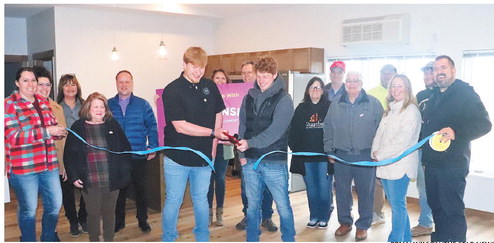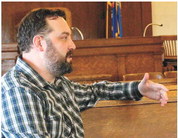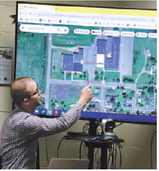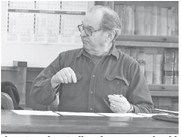Marathon’s utility commission tours new sewer plant
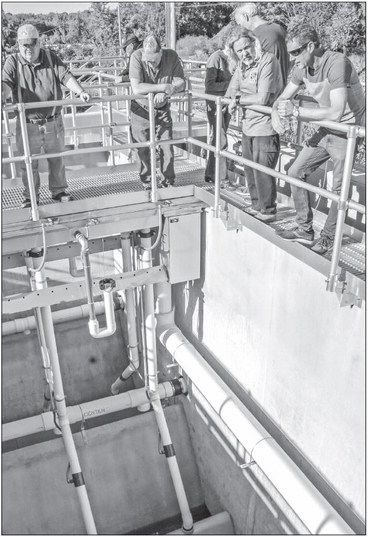

During a tour of Marathon City’s new sewage treatment plant last week, a member of the local utility commission asked a question that was likely on everyone’s mind.
“What kind of smell factor do you expect from this new facility?” wondered commissioner Bruce Bohr as he and other offi cials strolled along metal catwalks and peered into open-air concrete tanks that will soon be used to treat the village’s wastewater.
Utility superintendent Ken Bloom, who led the tour, assured Bohr and others that any odor coming from the new Aero-Mod system would be minimal, since the new plant depends more on aeration and does not include primary clarifiers that settle out solid waste.
“I don’t think it’ll be very bad at all,” he said. “I think it’ll actually be less than our current facility.”
Bloom explained in detail how incoming waste will travel through the multi-stage aerobic digester system before being released into the nearby Big Rib River as treated effluent. The bulk of the new facility consists of interconnected chambers where waste will be fermented, aerated and broken down by bacteria.
The old plant uses anaerobic digesters, which must be heated to a temperature of 96 degrees Fahrenheit using a boiler system that will no longer be needed, Bloom said.
“We’re going to be using more air and more electricity than we were before, but we won’t use much natural gas,” he said.
The plant is also equipped with an ultraviolet (UV) disinfection system to remove viruses and bacteria from the wastewater before it enters local waterways. Bloom said the UV system, which uses a lot of electricity for high-intensity light bulbs, will run from May 1 through Sept. 30 each year, in accordance with DNR rules.
SachaTetzlaff,anengineerwithStrand Associates, said the concrete treatment tanks do not contain much mechanical equipment, and whatever is there can be brought to the surface for repairs and replacement, eliminating the need to drain the tanks for maintenance.
Tetzlaff said Bloom will be able to reprogram the treatment system whenever needed, to account for changes in the weather and other factors, with the ultimate goal of consistently meeting the discharge limits set by the Wisconsin DNR. He said the facility will need to be operated in a way that is unique to Marathon’s treatment needs. “You can build this exact same plant in another community, and it’ll behave completely differently because the wastewater coming in just has different characteristics,” he said.
The new plant, which is located just across East Street from the high school’s football field, was constructed directly adjacent to the village’s old sewage treatment facilities, some of which will be demolished.
In March of last year, the commission awarded an $8.66 million contract to Market & Johnson of Eau Claire to build the facility, which was designed by Strand Associates and approved by the village in 2020. The total cost, including engineering, is estimated to be just under $10 million.
The project is being financed by an $8.7 million, 20-year loan from the Wisconsin DNR’s Clean Water Loan Fund, which is also providing a $1 million principal forgiveness grant. In order to pay back the loan, local sewer rates will more than double by the time the project is closed out. Earlier this year, the commission passed a resolution to raise rates by 19 percent as of July 1 and by another 19 percent on Jan. 1, 2024, completing a five-year phase-in of rate hikes. As a result, the average customer using 9,210 gallons per quarter will pay a total of about $230 in quarterly sewer fees, up from about $104 in 2019.
At the end of the tour, Tetzlaff told commissioners that the village had spent its money wisely on building a new treatment facility.
“You have made a wonderful investment, and you have a good guy here to run it and take care of it for you,” he said, referring to Bloom.
Before touring the plant at its Aug. 30 meeting, commissioners discussed a memo from Strand Associates requesting up to $170,140 in additional payments for continuing to do work beyond the original scope of the project. The firm’s original contract covered its services through the month of July, but multiple delays in equipment deliveries have pushed the substantial completion date out to Oct. 21.
Kurtz told the commission that he does not believe the village should be on the hook for paying all of Strand’s additional fees, since it was not responsible for the equipment delays. He planned on raising the issue with the contractor during a regular construction meeting this week.
The administrator also noted that the village could start charging Market & Johnson liquidated damages, as specifi ed in its contract, for failing to complete the project on time, which would help the village recoup any additional costs.
The AeroMod was originally expected to come online in March, but because several electrical components did not arrive on time, the start-up date has been moved to Sept. 11. The new facility needs to be run for a month before the old plant can be shut off.
Once it’s operational, the new plant will be able to treat 265,000 gallons of wastewater per day, compared to the 250,000 gallons the old plant could treat. The facility is also expected to more efficiently remove phosphorus, helping the village meet the ultra-low limit set by the DNR.
Other business:
Bloom told the commission that water samples were tested for copper and lead at 10 different locations throughout the village, and all of the results came back within safe limits.
Bloom said one of the boilers at the water treatment plant is out of service, leaving the facility without a backup. Village administrator Andy Kurtz said the entire boiler system needs to be replaced, the cost of which will be included in next year’s budget.
Commissioners were told that Sulzer Machine has asked to start sending its industrial waste to the village’s sewer plant for treatment. Bloom said the utility will start accepting a small amount of the company’s waste in late September, and depending on the results, the amount will increase over time and Sulzer will be charged a special fee.
Bloom said a new 10-inch water main has been installed on Third Street, from Pine Street to West Alley, and two safe water samples have been obtained.
Kurtz said he spoke with an employee at William Reid LTD about ongoing issues with a lift station installed by the company. He said the representative was not previously aware of the problem and assured him it “would be taken care of in short order.” Kurtz said he expects the village to basically get a “brand-new” lift station as a result, but he still needs to talk to William Reid about reimbursing the village for the money it spent proving the facility was faulty.
Thecommissionapproveda$252,786 pay request from Market & Johnson and a $55,800 invoice from Strand Associates for work done on the new sewer plant. A disbursement request totalling $308,586 from the DNR’s Clean Water Loan Fund was also approved.

